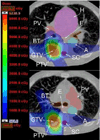Improving radiation conformality in the treatment of non-small cell lung cancer
- PMID: 20652085
- PMCID: PMC2905742
- DOI: 10.1016/j.semradonc.2010.01.005
Improving radiation conformality in the treatment of non-small cell lung cancer
Abstract
One of the many challenges of lung cancer radiotherapy is conforming the radiation dose to the target due to tumor/organ motion and the need to spare surrounding critical structures. Evolving radiotherapy technologies, such as four-dimensional (4-D) image-based motion management, daily on-board imaging and adaptive radiotherapy, have enabled us to improve the therapeutic index of radiation therapy for lung cancer by permitting the design of personalized treatments that deliver adequate doses conforming to the target while sparing the surrounding critical normal tissues. Four-dimensional computed tomography (CT) image-based motion management provides an opportunity to individualize target motion margins and reduce the risk of a geographical target miss. Daily on-board imaging and adaptive radiotherapy reduce set-up and motion/anatomy uncertainties over the course of radiotherapy. These achievements in image guidance have permitted the implementation in lung cancer patients of highly conformal treatment delivery techniques that are exquisitely sensitive to organ motion and anatomic change such as intensity-modulated radiation therapy, stereotactic body radiation therapy, and proton therapy. More clinical studies are needed to further optimize conformal radiotherapy using individualized treatment adaptations based on changes in anatomy and tumor motion during the course of radiotherapy and using functional and biological imaging to selectively escalate doses to radioresistant subregions within the tumor.
Figures



Similar articles
-
Image-guided radiation therapy for non-small cell lung cancer.J Thorac Oncol. 2008 Feb;3(2):177-86. doi: 10.1097/JTO.0b013e3181622bdd. J Thorac Oncol. 2008. PMID: 18303441 Review.
-
Potential for reduced toxicity and dose escalation in the treatment of inoperable non-small-cell lung cancer: a comparison of intensity-modulated radiation therapy (IMRT), 3D conformal radiation, and elective nodal irradiation.Int J Radiat Oncol Biol Phys. 2003 Nov 1;57(3):875-90. doi: 10.1016/s0360-3016(03)00743-0. Int J Radiat Oncol Biol Phys. 2003. PMID: 14529795
-
Adaptive Dose Escalation using Serial Four-dimensional Positron Emission Tomography/Computed Tomography Scans during Radiotherapy for Locally Advanced Non-small Cell Lung Cancer.Clin Oncol (R Coll Radiol). 2016 Dec;28(12):e199-e205. doi: 10.1016/j.clon.2016.08.011. Epub 2016 Sep 13. Clin Oncol (R Coll Radiol). 2016. PMID: 27637725 Clinical Trial.
-
Dose escalation of radical radiation therapy in non-small-cell lung cancer using positron emission tomography/computed tomography-defined target volumes: are class solutions obsolete?J Med Imaging Radiat Oncol. 2008 Apr;52(2):168-77. doi: 10.1111/j.1440-1673.2008.01937.x. J Med Imaging Radiat Oncol. 2008. PMID: 18373810
-
Gating and tracking, 4D in thoracic tumours.Cancer Radiother. 2010 Oct;14(6-7):446-54. doi: 10.1016/j.canrad.2010.06.002. Epub 2010 Jul 31. Cancer Radiother. 2010. PMID: 20673737 Review.
Cited by
-
CT-guided iodine-125 brachytherapy as salvage therapy for recurrent mediastinal lymph node metastasis.Thorac Cancer. 2021 May;12(10):1517-1524. doi: 10.1111/1759-7714.13932. Epub 2021 Mar 14. Thorac Cancer. 2021. PMID: 33719222 Free PMC article.
-
Proton therapy in clinical practice.Chin J Cancer. 2011 May;30(5):315-26. doi: 10.5732/cjc.010.10529. Chin J Cancer. 2011. PMID: 21527064 Free PMC article. Review.
-
Local and systemic therapies for malignant pleural mesothelioma.Curr Treat Options Oncol. 2014 Dec;15(4):683-99. doi: 10.1007/s11864-014-0314-4. Curr Treat Options Oncol. 2014. PMID: 25266654 Review.
-
Enhancement of Radiation Sensitivity in Lung Cancer Cells by a Novel Small Molecule Inhibitor That Targets the β-Catenin/Tcf4 Interaction.PLoS One. 2016 Mar 25;11(3):e0152407. doi: 10.1371/journal.pone.0152407. eCollection 2016. PLoS One. 2016. PMID: 27014877 Free PMC article.
-
Computed tomography patterns and clinical outcomes of radiation pneumonitis in non-small-cell lung cancer patients.Acta Radiol Open. 2024 Oct 1;13(10):20584601241288502. doi: 10.1177/20584601241288502. eCollection 2024 Oct. Acta Radiol Open. 2024. PMID: 39380891 Free PMC article.
References
-
- Curran W, Scott C, Langer C, et al. Long term benefit is observed in a phase III comparison of sequential vs. concurrent chemo-radiation for patients with unresectable NSCLC:RTOG 9410. Proc Am Soc Clin Oncol. 2003;22:621a.
-
- Socinski M, Rosenman J, Halle J, et al. Dose-escalating conformal thoracic radiation therapy with induction and concurrent carboplatin/paclitaxel in unresectable stage IIIA/B non-small cell lung carcinoma. Cancer. 2001;92:1213–1223. - PubMed
-
- Schild S, McGinnis W, Graham D, et al. Results of a phase I trial of concurrent chemotherapy and escalating doses of radiation for unresectable non-small-cell lung cancer. Int J Radiat Oncol Biol Phys. 2006;65:1106–1111. - PubMed
-
- Xia T, Li H, Sun Q, et al. Promising clinical outcome of stereotactic body radiation therapy for patients with inoperable stage I/II non-small cell lung cancer. Int J Radiat Oncol Biol Phys. 2006;66:117–125. - PubMed
-
- Onishi H, Araki T, Shirato H, et al. Stereotactic hypofractionated high-dose irradiation for stage I non-small cell lung carcinoma clinical outcome in 245 subjects in a Japanese multi-institutional study. Cancer. 2004;101:1623–1631. - PubMed
Publication types
MeSH terms
Grants and funding
LinkOut - more resources
Full Text Sources
Medical

